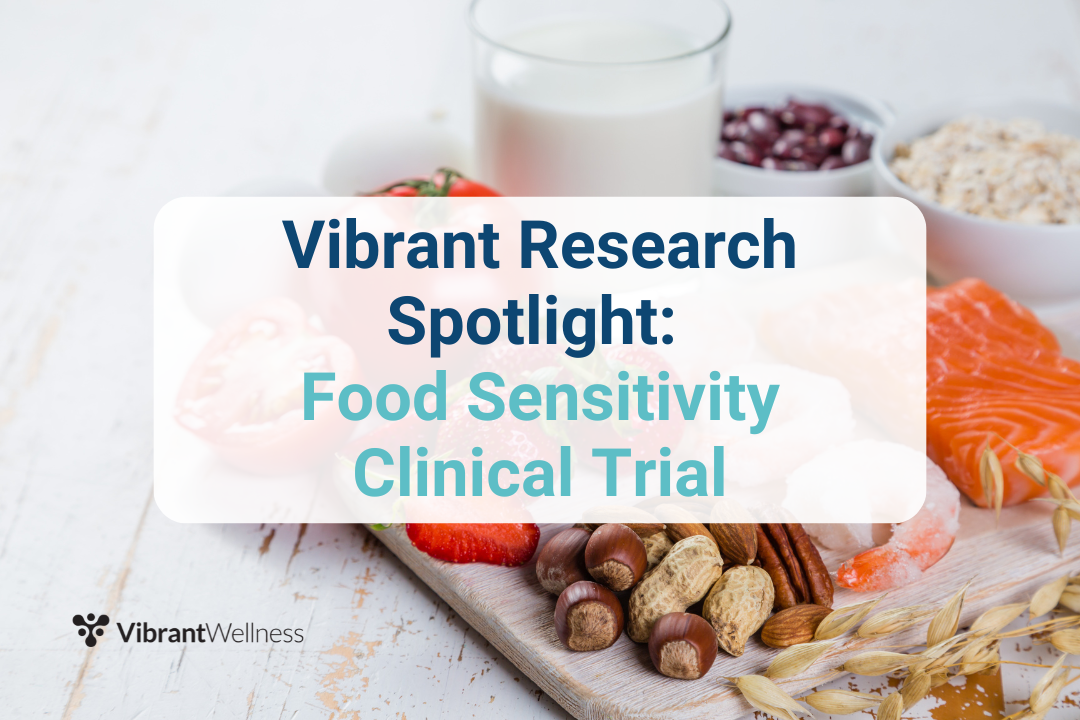The Link Between Diet and Disease: Insights from Food Sensitivity Testing
The diet and disease relationship is well established and has gained significant attention in the face of chronic ailments that may be rooted in poor nutrition.
Our dietary choices strongly impact our overall health, influencing everything from digestion to immune function.
However, it’s not as simple as “eating healthy.” Immune reactions to seemingly harmless foods can fuel chronic inflammation, and, in the long term, diseases linked to diet.
In this blog, we’ll investigate the nature of food sensitivities, the relationship between diet and disease, and advanced diagnostic tools for managing these reactions.
Table of Contents
The Overlooked Impact of Food Sensitivities on Health

While most people are aware of common food allergies and diet triggers that are severe, food sensitivities often go unnoticed. Yet, they can contribute to a range of chronic health issues.
Unlike food allergies, which provoke an immediate immune response, food sensitivities cause delayed reactions that can be subtle and difficult to trace back to specific foods.
Food sensitivities can manifest in various ways, including gastrointestinal problems, migraines, skin conditions, and fatigue.
These symptoms can persist for years, leading to misdiagnoses and ineffective treatments.
Understanding and identifying food sensitivities is crucial for developing effective dietary interventions and improving well-being.
Food Sensitivity Symptoms: A Broad Spectrum

Unlike immediate allergic reactions, food sensitivities can lead to delayed and often subtle symptoms that are challenging to diagnose without proper testing.
One of the major antibodies involved in food sensitivity reactions is IgG, the most common antibody found in blood circulation.
IgG-mediated food reactions are linked to a wide range of symptoms, including allergy-like symptoms such as rashes, urticaria, and asthma.
Additionally, gastrointestinal symptoms like abdominal cramps, diarrhea, and constipation are also common, which are suggestive of irritable bowel syndrome.
A strong association also exists between neurological manifestations such as migraines and IgG-mediated food reactions.
Finally, food reactions have been linked with disorders such as atherosclerosis and asthma, as well as non-specific symptoms such as chronic fatigue and hair loss.
Studies show that removing trigger foods from the diet can significantly improve symptoms in patients with these reactions, signifying the interplay between diet and disease.1
The challenge is in identifying and diagnosing specific food sensitivities.
What Can A Food Sensitivity Test Tell You?

Food sensitivity tests provide a comprehensive analysis of how your immune system reacts to various foods.
This allows you to draw connections between your diet and disease risk as well as current symptoms.
To determine the source of symptoms, diagnostic tests measure the presence of antibodies in response to specific foods.
A food sensitivity test may test for various antibodies including IgA, IgG, IgG4, and c3d.
IgA antibodies are one of the body’s first lines of defense. They’re present in areas of the body that contain high mucosa, such as the gastrointestinal tract, lungs, sinus, and bladder, because these are major sites of potential attack from microorganisms.
IgG antibodies are the most abundant class of antibodies found in the bloodstream. They play an essential role in the immune response by recognizing and binding to foreign substances, such as pathogens or food antigens.
IgG4 antibodies are a subclass of immunoglobulin G (IgG) antibodies. They have distinct properties and functions, such as acting as an IgE blocking agent. IgG4 has also been identified as an anti-inflammatory antibody that increases in states of immune tolerance.
C3d is a part of the complement system, a component of the immune system that enhances antibodies’ ability to clear pathogens from an organism. Specifically, C3d is a fragment of the complement protein C3.
The C3d immune response is measured to determine complement system activation to various foods. When the complement system is activated, the body experiences an exaggerated immune response and its accompanying inflammation.2
These antibodies indicate specific immune reactions to particular food proteins, helping to pinpoint which foods may be causing adverse symptoms and elucidate the interactions between diet and disease.
The antibodies also demonstrate an inflammatory immune reaction, which, over time, can lead to chronic symptoms and the development of diseases linked to diet.
The Diet-Disease Relationship: Food Sensitivity and Disease Development
While some symptoms of food sensitivity can seem mild at first, over time, the chronic inflammatory reaction can trigger the development of serious illness, illustrating the close connection between diet and disease.
Food Sensitivities & Autoimmune Disease

Autoimmune disease occurs when the body confuses its own tissue with something foreign and thus attacks itself.
When this happens, something seemingly harmless can cause an adverse reaction in the body.
This can be seen in food protein-induced autoimmunity, where immune reactions to food proteins lead to eventual autoimmune development, further highlighting the link between diet and disease.
The main mechanisms involved in food protein-induced autoimmunity are antibody cross-reactivity and covalent binding of food and human tissue proteins.
One example is the shared structure between gluten, dairy proteins, and human tissues.
Due to this similarity, if antibodies are produced against gliadin, a primary protein found in gluten, those gliadin antibodies could potentially mistake cerebellar tissue or thyroid peroxidase for gliadin and, thus, produce antibodies against their own tissue, leading to autoimmunity.3
This phenomenon is what causes celiac disease to develop. While celiac is the most well-known example of diseases linked to diet, gluten proteins and other wheat proteins are also linked to various other diseases, including neurological, cardiovascular, thyroid, and joint disorders, showing the diverse manifestations of diet and disease interplay.3

This is due to an affinity for gliadin antibodies to bind to human tissue beyond the gut. This ability may be relevant to disorders other than celiac, like non-celiac gluten sensitivity (NCGS).
NCGS is defined as intestinal and extra-intestinal symptoms related to ingesting gluten-containing foods in the absence of celiac disease and wheat allergy.
NCGS is challenging to diagnose as these patients will test negative for celiac disease and gluten allergy. Food sensitivity testing is the most efficient way to distinguish NCGS from other ailments, reinforcing the importance of understanding the connection between diet and disease.
Finally, autoimmune disorders are more common in women, and studies show that food sensitivities are also significantly more common in females than in males.
Women are also more likely to suffer from hypersensitivity reactions.
One reason for this may be that female sex steroids are known for exerting a strong pro-inflammatory effect in the induction of allergies, further complicating the diet and disease relationship.1
Understanding the interplay between food sensitivities, food allergies, and diet is crucial for effectively managing these hypersensitivity reactions.
Food Sensitivities & Digestive Disorders

In addition to autoimmunity, food sensitivity can also trigger the development of various digestive disorders.
One such example of the diet and disease relationship is intestinal bowel disorder (IBD).
Studies show that IgG antibodies against food-specific allergens are distinctly elevated in IBD patients compared with healthy controls.
While healthy individuals also contain IgG antibodies, many studies have linked a higher prevalence of these antibodies to IBD patients.
The relationship between IBD and food sensitivity and intolerance is complex.
In IBD patients, damaged gut lining leads to increased permeability, allowing immune cells to encounter food antigens.
This interaction can trigger high levels of IgG antibodies and worsen inflammation.
Additionally, the absence of certain digestive enzymes, seen in food intolerance, can result in undigested food particles that stimulate antibody production and inflammatory responses, further damaging the intestines.4
Further, patients with Crohn’s disease were similarly shown to be more sensitive to exogenous food antigens than healthy people, and their reactions were gut-specific.4
By testing for specific food-related antibodies, you can understand the underlying mechanisms of food-related health issues and the chronic diseases linked to diet.
This leads to more effective management and treatment plans tailored to your unique immune responses.
You can repeatedly take food sensitivity tests to monitor how dietary changes impact the immune system's response to foods over time.
This ongoing evaluation helps to refine dietary plans and ensure they remain effective.
It also allows you to gain insights into your diet and disease risk over time, track your progress, and make necessary adjustments to optimize your health.
IgG Antibodies & Food Reactions: Understanding the Diet and Disease Connection

Food sensitivities are immune-mediated reactions to food protein antigens, in which antigens bind to antibodies and form an antigen-antibody immune complex.
This phenomenon, known as loss of oral tolerance, occurs when the intestinal immune system reacts to typically harmless foods.
IgG antibodies are highly influential components in these immune reactions. The immune system produces these antibodies in response to exposure to specific food proteins.
This process can take days to months, making it difficult to associate symptoms with specific foods immediately.1 When these antibodies bind to food antigens, the immune complexes they form can trigger systemic inflammation and various chronic symptoms.
IgG antibodies can activate immune cells such as mast cells and macrophages.
Traditionally, mast cells are associated with IgE-mediated allergic reactions, but IgG can also stimulate these cells, leading to the release of inflammatory mediators.
This activation can result in symptoms similar to those caused by food allergies and dietary triggers, including gastrointestinal issues, headaches, and skin conditions.
Contrary to the traditional view that IgG antibodies suppress allergic responses, recent research suggests they may actually promote hypersensitivity reactions.4
IgG antibodies can interact with allergens in ways that enhance immune responses, contributing to chronic inflammation and other symptoms associated with food sensitivities.
These interactions are a crucial part of understanding how diet and disease affect each other and the body.
Due to the delayed nature of IgG antibody formation, diagnosing food sensitivities through IgG testing can help identify problematic foods that are not immediately obvious.
This allows for more targeted dietary interventions, improving outcomes by reducing exposure to trigger foods.
The exact role of IgG antibodies in food sensitivities and the diet-disease relationship still needs to be fully understood and remains a subject of ongoing research.
What is the Root Cause of Food Sensitivities?
Food sensitivities arise from various factors, including genetics, gut health, and immune responses.
Food Sensitivities and Genetics

Genetic predispositions can affect how your body processes and reacts to certain foods, leading to chronic symptoms triggered by your diet, and disease development in serious cases.
For example, histamine intolerance is caused by an imbalance of accumulated histamine and the ability to degrade histamine.
Histamine is a natural amine derived from L-histidine and is present in many foods, including alcohol, processed meat, and fruits and vegetables like tomatoes and eggplant.
In healthy people, exogenous or dietary histamine is eliminated primarily using intestinal diamine oxidases (DAOs), a type of enzyme.
However, certain genetic polymorphisms can cause an insufficient expression of secretory DAO, increasing the risk of histamine toxicity in the human body.
Food Sensitivities and Environmental Factors

Environmental factors can also trigger or exacerbate food sensitivities, indirectly impacting the diet-disease relationship.
Exposure to environmental toxins like pollutants or mold can compromise the body’s ability to process certain foods effectively—primarily due to the damage toxins can inflict on the gut. This connection between diet and disease becomes evident as these toxins can significantly affect gut health.
For instance, mycotoxins can damage gut health by disturbing the gut barrier and inducing inflammation. These processes can then lead to the development of various food sensitivities.
One example is Reovirus. Researchers suspect that reovirus infection disrupts the host's immune response to food antigens and contributes to the development of celiac disease and loss of oral tolerance to food.
Additionally, lifestyle factors such as stress, lack of sleep, and poor dietary habits can weaken the digestive system, making it more susceptible to food sensitivities, and affecting the diet and disease relationship.
Food Sensitivities and Gut Health

One of the most influential factors in the development of food sensitivities, and the relationship between diet and disease, is gut health. The gut microbiome, composed of trillions of bacteria, plays a vital role in digestion and immune function.
Gut microorganisms can degrade or modify food antigens or allergens, increasing or reducing their immunogenicity—the immune response they trigger.
One key factor in the development of food sensitivities is intestinal barrier dysfunction, also known as leaky gut, which can be influenced by gut microorganisms and pathogens through different pathways.5
This can allow undigested food particles to enter the bloodstream, triggering food-specific IgG production and chronic inflammation.
This increased production of food-specific IgG antibodies, coupled with decreased production of anti-inflammatory cytokines such as IL-10 and TGFβ1, has also been linked to irritable bowel syndrome, highlighting the significant impact of gut health on the diet and disease relationship.1
What is the Science Behind Food Sensitivity Tests?
%20(1)-1.png?width=800&height=406&name=Tickborne%20Diseases%20%20Advanced%20Detection%20Technology%20(800%20x%201200%20px)%20(1)-1.png)
Food sensitivity tests use advanced technology to measure the body's immune response to specific foods.
The process begins with collecting a blood sample, which is then analyzed for antibodies like IgG and IgA. These antibodies indicate how the immune system reacts to various foods, helping to identify sensitivities.
Our lab team utilizes microarray technology, which involves synthesizing proteins on silicon wafers to detect antibody-antigen binding.
This method allows for high-throughput screening of numerous food antigens simultaneously, ensuring comprehensive analysis.
We also use chemiluminescence detection to enhance the sensitivity and specificity of the tests. Chemiluminescence involves labeling antibodies with a luminescent marker that emits light when they bind to their target antigen.
The intensity of the light emission is measured, providing a quantitative assessment of antibody levels. This technology reduces the likelihood of false positives and negatives, ensuring more accurate results.
Benefits of Vibrant testing include:
- High Sensitivity and Specificity: Our tests achieve high sensitivity and specificity by combining microarray technology and chemiluminescence detection. This means they can accurately detect even low levels of antibodies, providing reliable information about food sensitivities and offering valuable insights into how diet and disease interact.
- Comprehensive Panels: We offer various comprehensive testing panels, such as the Food Sensitivity Test Complete and Food Zoomers. These panels assess sensitivities to a wide range of foods, including whole, raw, and water-soluble proteins. The Food Zoomers tests target specific food categories like wheat, corn, dairy, and more, revealing how the body reacts to these food groups.
- Validation and Accuracy: Our tests are validated through rigorous research and clinical trials, producing accurate and reproducible results.
Are Food Sensitivity Tests Worth the Money?

Investing in food sensitivity tests can help you significantly improve your health and day-to-day life.
By identifying and eliminating trigger foods, you can enhance your gut health, improve digestion, and reduce inflammation.
Additionally, food sensitivities can cause chronic inflammation, contributing to various health issues.
Addressing these sensitivities and the link between diet and disease can help reduce inflammation and potentially prevent major illnesses.
Finally, understanding and managing food sensitivities can improve your energy levels, mood, and overall quality of life.
While elimination diets and food journals are alternative methods to identify food sensitivities, they can be time-consuming and less precise.
An elimination diet involves removing suspected foods from the diet and gradually reintroducing them to identify triggers. While effective, it requires significant time and effort.
Keeping a food journal can help track symptoms and identify potential food sensitivities. However, this method relies on self-reporting and may not capture all sensitivities accurately.
Food sensitivity tests offer a more efficient and comprehensive approach that allows you to identify which foods are problematic, remove them, and restore your health.
This will help you reduce the inflammatory triggers in your diet and disease risk, leading to enhanced quality of life.
What is the Cure for Food Sensitivities & Intolerances?
Currently, there is no definitive cure for food sensitivities or intolerances. However, effective strategies can significantly reduce symptoms and help you manage the diet and disease relationship.
Dietary Adjustments
The cornerstone of managing food sensitivity is eliminating or reducing the intake of trigger foods.
This involves identifying the specific foods that cause adverse reactions and removing them from the diet.
Personalized nutrition plans based on food sensitivity test results can help you avoid these triggers.
Regular consultations with a dietitian or nutritionist can ensure your dietary adjustments are balanced and nutritionally adequate, helping you navigate the diet and disease dynamic.
Gut Health Support
Supporting your gut health is crucial in managing food sensitivities and the diet and disease relationship. A healthy gut barrier prevents food particles from leaking into the bloodstream and triggering immune responses through intestinal permeability.
See how to create a gut health food plan.
Lifestyle Changes

Lifestyle factors such as stress, sleep, and physical activity can influence food sensitivities.
Chronic stress can weaken the immune system and exacerbate symptoms, so stress management techniques like mindfulness, meditation, and regular exercise are beneficial.
Ensuring adequate sleep is also crucial for immune health and overall well-being.
These strategies can help mitigate the inflammatory processes triggered by diet and disease, leading to better outcomes.
Diagnostic Solutions: Advanced Food Sensitivity Testing

The most efficient way to identify and address food sensitivities is through precision testing.
Vibrant Food Sensitivity tests are blood panels that detect sensitivities to up to 209 different foods.
The panels assess different immune responses to whole, raw, and water-soluble proteins commonly consumed to determine your risk for negative food reactions.
Food Sensitivity Test panel options include:
- Food Sensitivity Profile 1 (96 foods)
- Food Sensitivity Profile 2 (84 foods)
- Food Sensitivity Complete (209 foods)
Each panel also comes with two different options for antibody testing: IgA and IgG or IgG4 and C3D.
Alternatively, you can combine both antibody options to fully assess food sensitivity by measuring IgA, IgG, IgG4 antibodies, and C3D together.
Vibrant Food Sensitivity tests use peptide microarray technology, which allows for:
- Highly precise detection of antibodies to foods
- High level of sensitivity and specificity
- Less false positive and negative results
- High reproducibility
Food sensitivity testing will give you a specific and targeted list of reactive and non-reactive foods.
This will help you see which foods are well-tolerated and which are causing issues, allowing you to understand your symptoms and the diet and disease interplay in your body.
Wheat Zoomers and Food Zoomers

Vibrant's Food Zoomers are another option you can use to detect food sensitivities.
The Food Zoomers are blood tests that use IgA and IgG antibodies to measure immune system reactivity to small peptides formed when whole proteins are broken down by digestion—unlike the Food Sensitivity tests, which measure whole proteins.
There are nine different Food Zoomer tests, including:
- Wheat Zoomer
- Corn Zoomer
- Dairy Zoomer
- Egg Zoomer
- Grain Zoomer
- Lectin Zoomer
- Soy Zoomer
- Peanut Zoomer
- Nut Zoomer
The Wheat Zoomer is especially useful as wheat is a major allergen.
The Wheat Zoomer is a highly intricate panel that tests for sensitivity, allergy, and autoimmune reactions to wheat.
These tests provide a comprehensive analysis of how your body reacts to various foods, including wheat and other common allergens.
The detailed reports help you understand which foods to avoid and which might be safely reintroduced over time.
Through these advanced testing methodologies, you can create personalized strategies that address the root causes of food sensitivities and help balance your diet and disease risk, leading to improved health outcomes.
Food Sensitivities, Disease, and Promoting Long-Term Health

Food sensitivities are complex processes rooted in the immune system’s adverse response to seemingly harmless food proteins.
These reactions often don’t manifest as severe and immediate responses to food the way allergies do, making it difficult to pinpoint whether food even is the problem, and, if it is, which food is responsible.
By consuming foods that elicit an immune reaction, over time, you contribute to chronic inflammation and diet and disease interactions.
Food sensitivity testing directly addresses this issue by offering valuable insights into the various types of immune responses to hundreds of different foods.
By identifying specific food sensitivities, tests like the Food Sensitivity Complete and Food Zoomers enable you to create personalized nutrition plans that address the root causes of symptoms.
Advanced technologies such as silicon microarray and chemiluminescence detection ensure these tests are highly sensitive and specific, providing accurate and detailed results.
Investing in food sensitivity tests can help improve gut health, reduce inflammation, and enhance overall well-being.
Additionally, identifying food sensitivities can provide insights into diseases like IBD and celiac and their development.
With early intervention, you can better navigate the diet and disease relationship, avert chronic inflammation, and potentially prevent the development of chronic illness.
While there is no cure for food sensitivities, effective management strategies can help you alleviate symptoms, improve quality of life, and position yourself to achieve longevity.
Want to learn more about food reactions and related diseases?
Read these next:
The Impact of Food Sensitivities on Daily Life and How to Discover Yours
The Genetic Roots of Celiac Disease
B-Cell Epitopes as Novel Biomarkers for the Detection of Celiac Disease
References:
- Skar GL, Simonsen KA. Lyme Disease. [Updated 2024 Jun 9]. In: StatPearls [Internet]. Treasure Island (FL): StatPearls Publishing; 2024 Jan-. Available from: https://www.ncbi.nlm.nih.gov/books/NBK431066/
- Lochhead, R.B., Strle, K., Arvikar, S.L. et al. Lyme arthritis: linking infection, inflammation and autoimmunity. Nat Rev Rheumatol 17, 449–461 (2021). https://doi.org/10.1038/s41584-021-00648-5
- Yehudina Y, Trypilka S. Lyme Borreliosis as a Trigger for Autoimmune Disease. Cureus. 2021 Oct 10;13(10):e18648. doi: 10.7759/cureus.18648. PMID: 34786243; PMCID: PMC8578812.
 By
By



